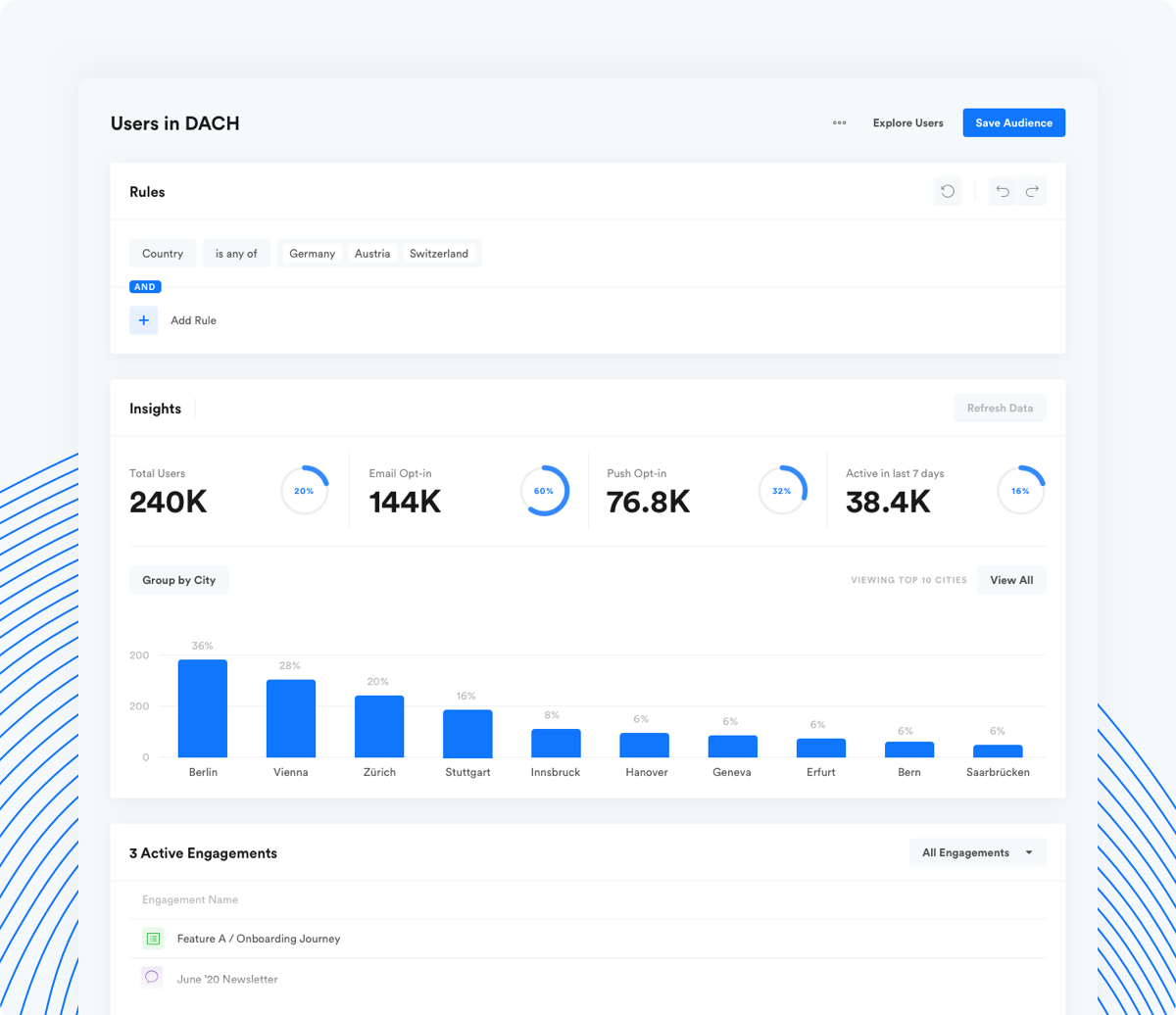Preparing for the holiday shopping season has always been quite an undertaking for retailers and e-commerce businesses, but this year may prove to be the most unpredictable and challenging one yet. Covid-19, the upcoming US elections and general consumer uncertainty about the economy will affect how, where and when consumers shop for the holidays. Leanplum is here to help businesses run effective engagement campaigns to have a successful 2020 holiday season.
Holiday 2020 Predictions and Trends
As the Covid-19 pandemic reshapes our world, we’ve seen a noticeable shift in consumers’ shopping behavior – from instore to online. According to Forbes Covid accelerated e-commerce growth by 4-6 years and Deloitte predicts e-commerce sales will grow by 25%-35% year-over-year during the 2020 holiday season.
70% of US consumers intend to make the majority of their holiday purchases online this year via web or mobile and 37% of US consumers said they were more interested in mobile app shopping than they were last year. In fact, App Annie predicts the biggest Q4 holiday shopping season on mobile yet – with nearly 1 billion hours to be spent on Android devices in the US alone, up 50% YoY. This holiday shopping season will also be a longer, more drawn out one due to Amazon’s Prime Day happening the second week in October as well as constraints on consumer spending.
Naturally, due to the increased volume of online shopping this year, we’ve already seen logistical constraints for FedEx, UPS and USPS. We expect this to lead to earlier shipping cutoffs and order delays. For e-commerce businesses, this could result in order cancellations and increased customer support requests.
As is apparent from the predictions thus far, this holiday shopping season will be different in many ways and thus requires adjusting your business strategy.
Below are five tips on how businesses can best tackle this unpredictable Q4.
1. Ensure Your E-commerce Campaigns Are Running Smoothly
As businesses are hyper focused on holiday creative and promotions, they should not forget about key e-commerce campaigns such as abandoned cart, browse and search campaigns. These are evergreen engagement campaigns that will deliver revenue all year long and will see a particular increase in both volume and revenue during the holiday shopping season.
First off, conclude any A/B testing you’re running on these campaigns to ensure you are running on the most optimized messaging and delivery timing throughout the holidays. Next, review the content of your message to make sure it’s relevant and on brand. Additionally, given the expected shipping delays consider adding content around shipping updates and/or customer support options and FAQs.
Lastly, ensure your campaigns are still effective given the expected increase in volume. Potentially, you will need to adjust the frequency of messages being sent to consumers as they will be searching, browsing and adding to their cart earlier and more regularly. While reminding a consumer to come back to purchase an item left in their cart is important, you may want to make sure they don’t get an individual reminder for every item they leave in their cart. Find the right balance between sending important messages and avoiding message overload, especially given that you will probably increase your promotional campaigns during this time as well.
2. Start Promotions and Engage Consumers Early
With expected shipping delays and events like Amazon prime day now happening in mid October, many e-commerce businesses are starting holiday promotions even before Black Friday. This means that consumers will start evaluating different promotions earlier and potentially start making purchases earlier this year. Adjust your promotional calendar so you can capitalize on this early shopping behavior and spread out shipping.
From an engagement perspective, communicate early promotions to your customers via their preferred channel (push, email, sms, etc.) and re-engage consumers who are showing interest in your products via additional messaging and/or your key e-commerce campaigns. Personalization is key here, but more on that later.
3. Build in Flexibility
While it’s important to have a holiday strategy in place, an unpredictable holiday season requires flexibility in your communication and engagement plan.
Given the longer shopping season, consumers will make purchase decisions at different points in time as opposed to over a few key dates. What this means for your engagement strategy is that important metrics for your campaigns, such as open and click-through rates, are likely to be different compared to previous holiday seasons. Thus, you’ll need to build in multiple engagement points to ensure the consumer comes back to your business to make a purchase. Re-engage users as they show interest in your products and promotions but haven’t purchased yet.
Keep in mind that shipping cutoff dates are still in flux, so while it is important to have promotional language around your last shipping date ready to go, remember you’ll need to be flexible when that messaging goes out. It is possible that changes will need to be made at the last minute, so you may also need to be prepared to send out additional communication to your customers. We suggest having good alignment with your operations/logistics teams to ensure that as a business you can respond to and engage with your users appropriately.
4. Emphasize Audience Segmentation
As more businesses make the shift from brick and mortar to e-commerce, we can expect an increase in promotional advertising and messaging. It’s likely that consumers will feel overwhelmed with the onslaught of holiday messaging and promotions so it is important to stand out from your competitors by personalizing your messaging to each consumer.
The first step to personalizing your messaging is proper audience segmentation, which relies on knowing your customers and having the right data and insights on their behavior. In the past, we’ve seen clients successfully use data ranging from previous purchase behavior, to purchase behavior last holiday season, to favorite product categories and favorite products, to location data in order to effectively segment their customer base. Ensure the audiences you need for segmentation are set up and ready to be utilized for holiday promotional messaging. We recommend having a thorough data review with your product/BIT team to ensure you can optimally use past touchpoints with customers to personalize your promotions and engagement during the holidays.
5. Personalize, Personalize, Personalize!
Once you’ve set up messaging campaigns for specific audiences, use what you know about your customers to personalize the content of the messages to them to cut through the clutter of promotions.
For example, if you send a push notification using the consumer’s first name or send them a promotion for a product they’ve shown an interest for in the past, this will resonate and stand out much more than a generic “20% off” push notification. Using historical data is a great way to personalize and continue to build relationships with your customers. Perhaps you still have data on their purchases from last season, if so, leveraging this might give you an edge when it comes to customer engagement this season.
How Leanplum Can Help You Win This Holiday Season!
By optimizing campaigns, improving purchase conversions, and continuously activating users on your mobile app or website, Leanplum can help marketing teams to get the most out of this holiday seasonA couple of Leanplum features that will make this season just a little smoother are audience management and content personalization.
Setting up holiday audiences ahead of time is a breeze using audience management capabilities. Audience management helps you build, manage, explore and activate customer data in the form of audiences. All audiences in Leanplum are dynamic, meaning you can always target your users based on up-to-date preferences and behaviors.
Personalize messages using Leanplum’s dynamic content capabilities. This allows you to personalize text, images and all other content based on customer data. Easily adjust a push notification or email to include the customers first name, and adjust messaging based on their preferred language, favorite products, personal discount codes
To learn how you can use Leanplum to your advantage, request a demo today!






